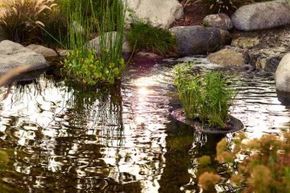Homeowners often expand their living spaces by building outdoor rooms and gardens. Garden and landscaping experts say that gardens should stimulate all the senses: sight, smell, hearing, taste and touch. The principles of feng shui demand incorporation of the vital, energy-giving elements earth, fire, wood, metal and water. Most of these features occur naturally in the outdoors, and you may already have added those that don't to your yard in the form of a grill (fire and metal). But sound is one of the easiest senses to overlook when planning your garden, and unless you have a waterfront home or a stream running through your property, water probably isn't a natural feature in your outdoor living space. How can you fill these voids in your garden world? By bringing both sound and water to your home with a pond.
Deciding where to build your pond is one of the most critical decisions you'll make. To ease this decision a little, determine where you can't put a pond. Ask your utility companies to mark the location of underground power, cable, natural gas and water lines. You'll also need to locate your sewer or septic drain lines, since you don't want to dig into them.
Advertisement
Of the areas left available, not all will be suitable for a pond. Low-lying areas flood in heavy rains, and the pond will suffer from contamination by lawn fertilizer or herbicides from the run-off of rain and routine watering. Avoid areas with heavy tree cover -- digging there is difficult and damaging to the trees. Also, when the leaves drop in the fall, they'll pollute your pond. Finally, the site must be big enough for the pond you want to build. Ideally, your pond will be on level ground with stable soil, close to electricity and water sources, in the correct mix of sun and shade, and located where you can always enjoy it.
Now that you've figured out where your pond will go, let's take a look at the different varieties of ponds you can build.


